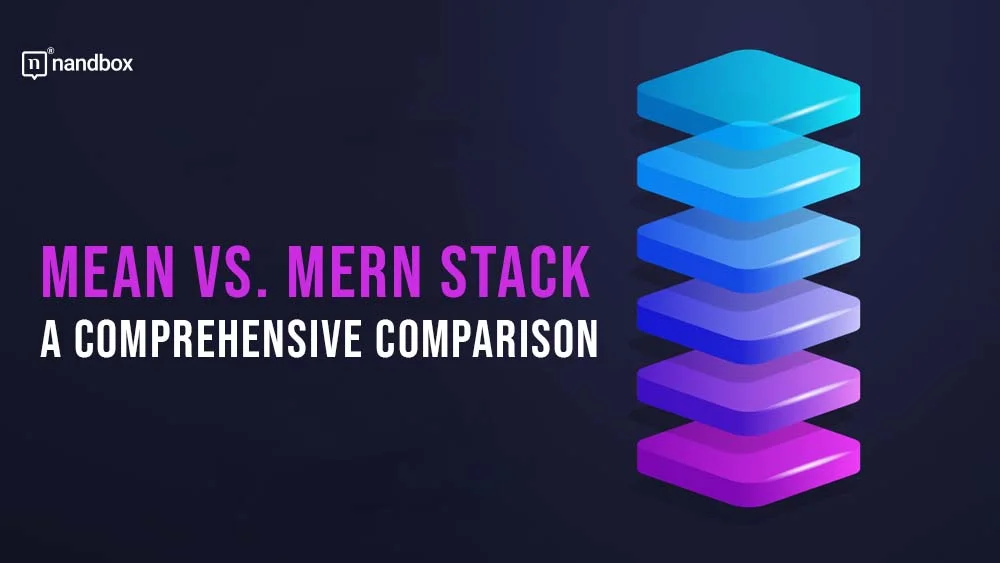A Closer Look at the MERN vs. MEAN Stack
Just like any other profession that usually has a predefined set of tools that make their jobs way easier and better, software developers do have the same predefined sets. Stacks are any software developer’s go-to when they would like to save time and effort and make their software development journey easier and more streamlined. Developers use these stacks for web, software, and app development. Among the many stacks that you can use for developing apps and websites, there are two that stood out and gained much recognition and popularity: the MERN and MEAN stacks. In this article, we will establish a great comparison of MERN vs MEAN stacks. Read this article to learn all about them: their definitions, advantages, and key differences.
What is MERN Stack?
As the name implies, a stack is a pile of things organized on top of each other. Sometimes it is clothes, books, pictures, etc. However, in this case, the stack is a pile of tools and resources organized to help software developers have an easy yet effective development experience. Each of these resources is usually used alone. However, when put together, each of these tools complements the other and fits together like a puzzle. The MERN stack is a comprehensive web and app structure and framework that includes all the libraries, tools, predefined codes, and resources needed for any development process.
MERN is an abbreviation for the main technologies and tools included in this stack, which are MongoDB, ExpressJS, React, and NodeJS. MERN stack is widely known for being easy to use and learn, as well as being a full-stack solution for developers that contains all that they would need throughout the development process.
Components of MERN Stack
To get a better glimpse of the MERN stack, let us break down each component, its role, and how it works.
MongoDB
Starting with the M, MongoDB is the first component. As any app, website, and software always receives input data from users, developers would definitely need somewhere to store such data. In this case, MongoDB is the one responsible for this duty. While relational databases like PostgreSQL offer strong structure for data with predefined relationships, MongoDB vs Postgresql offers greater flexibility in its schema. MongoDB is a great dataset tool that is responsible for storing every piece of input data. What makes MongoDB ideal and effective is that it is very reliable, and secure and can process and store large sets of data.
ExpressJS
The next component is ExpressJS. ExpressJS is responsible for building and establishing the back-end systems for websites and apps. It is the recipient of all the requests of users, and it is capable of handling them efficiently and effectively.
ReactJS
ReactJS is responsible for designing the interface that users can see and interact with, which can also be referred to as the front-end part of the software. You can guarantee a great and robust user interface, as ReactJS includes a rich and comprehensive library of JavaScript components that have whatever a developer needs.
NodeJS
NodeJS, the fourth and last component, ensures that a website or application is functional and runs as intended. Using JavaScript as its foundation, NodeJs generates the server-side code for the app, website, or program. Because of its cross-platform nature, NodeJS can also deploy applications on a wide range of operating systems.
What is MEAN Stack?
Just like the pile of tools that are present in the MERN stack and help developers experience an easy and swift app and web development journey, the MEAN stack does the exact same, with a few differences in the tools and technologies used. The MEAN stack is more specialized, as it is used often to develop web applications, which is one of the three types of applications a developer could create.
MEAN is an abbreviation of the four components in this stack, which are MongoDB, ExpressJS, Angular, and NodeJS. And yes, the MEAN and MERN stacks share three of the four components, but do they have the same roles?
Components of MEAN Stack
MongoDB
MongoDB serves the same function that it does for the MERN stack. That would be functioning as a no-SQL database tool that immediately stores the input data incoming from users.
ExpressJS
ExpressJS is also the same. It is responsible for establishing the back-end system and structure to process and handle incoming requests.
Angular
Now that we have come to the main difference that sets the MEAN vs MERN stack stacks apart. Angular also helps establish the front-end part of web apps. The same role as ReactJS. However, through Angular, a developer could create much more dynamic and intuitive user interfaces. Unlike React, it uses HTML syntax for creating those interfaces.
NodeJS
NodeJS also has the same function in the MEAN stack, which is running and generating the server-side code. This is to ensure the applications and websites have robust and proper functionality and smooth operation.
Exploring the Differences Between MERN and MEAN Stack
Front-End Technology
While deciding between the MERN and MEAN stacks, it’s crucial to think about the front-end technology that each uses. For the front end of the MERN stack, the go-to JavaScript library is React. Because of its component-based design, React can generate and update user interfaces quickly. The MEAN stack, on the other hand, is a front-end framework built on top of the Angular library. The Angular framework is a comprehensive resource for creating sophisticated web applications. While picking between MERN and MEAN, you should take into account the needs of your project and the expertise of your development team, as both React and Angular have advantages and disadvantages.
Project Complexity

Whether you go with the MERN or MEAN stack depends heavily on the complexity of your project. Angular is a good option to consider if the front end of your project has to be more complex and feature-rich. The powerful set of tools and functionalities provided by Angular simplifies the development of elaborate web apps. React, on the other hand, may be preferable if your project’s front end is less complex and you’d like a lighter, more adaptable solution. User interfaces can be rendered and updated quickly using React thanks to its component-based architecture.
Code Reusability
When deciding between the MEAN vs MERN stack, code reusability should be prioritized. While it is possible to reuse code in both stacks, they do so in unique ways. React and Express are only two examples of the JavaScript libraries used in the MERN stack to facilitate code reuse. These libraries supply units and components that can be used repeatedly and incorporated into the rest of your application with little effort. In contrast, JavaScript Frameworks are the major programming language in the MEAN stack, facilitating code reuse throughout the stack. Because of this, back-end code can be used on the front end, and vice versa. You should weigh the required level of code reuse for your project against the ease with which you can achieve it with each stack.
Scalability and Flexibility
Consider the MERN and MEAN stacks’ scalability and flexibility when weighing the differences. Despite their distinct characteristics, both stacks are very scalable to meet growing demands. Through the utilization of cloud-based services, scalability is attained in the MERN stack, allowing for effortless demand-based application expansion. If your user base expands, you can quickly scale up to accommodate the influx of new visitors. The MEAN stack, on the other hand, is scalable because it uses horizontal scaling, in which additional servers are added to handle increased traffic. As a result, there is more flexibility for accommodating heavy traffic. When deciding on a stack, think about the project’s scalability needs and how easily you can fulfill those needs with each option.
Development Speed
When deciding between the MEAN vs MERN stack, it’s also vital to think about how quickly you can build applications. The MERN stack’s rapid development time is due in large part to the fact that JavaScript is used for both the front end and the back end. Because of this, developers may avoid switching gears between languages and work more efficiently across the stack as a whole. The MEAN stack, on the other hand, provides rapid development speeds. However, developers may need more time to understand and master all the technologies involved. While deciding on a stack, take into account your skills as well as any time limitations associated with the project.
Final Thoughts
The choice between MEAN vs MERN stack fully depends on you. Before deciding on either, you should consider your requirements, skills, knowledge, and features. Do comprehensive research on the technologies, tools, and resources used. This will help you make well-informed decisions and avoid starting with one of the methods that could turn out poorly. Both stacks have their distinct characteristics, pros, and cons. If you are going for a more edge, complexity, and dynamic interface, then MEAN is your ultimate choice. However, if you are looking for a more simple solution where you can achieve minimal features, functions, and interface, then MERN is your go-to. However, both will also accomplish some exceptional outcomes and help you develop robust applications. So, whether you choose the MERN or MEAN stack, you can ensure a great outcome.






